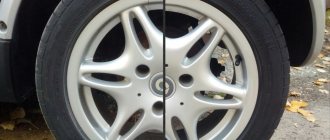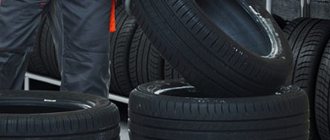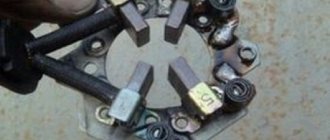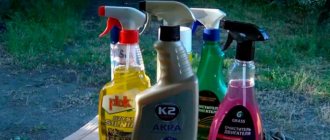Tire blackening agent used when caring for a vehicle and giving it aesthetics. There is a wide range of similar special products on the shelves of auto chemical stores. Do-it-yourself folk ones can also serve as a good alternative to some of them.
During the operation of a car, wheels are most susceptible to the influence of external factors. The sun, water, salts, chemicals and bumps on the road are the main culprits in the aging of a tire and the loss of its original (store) appearance. Restoration using the rubber blackening method will help restore freshness and former beauty. This can be done using several mixtures, in particular: glycerin, shoe polish, soap, silicone or a specially developed liquid. To figure out the best way to blacken tires, you should weigh all the pros and cons of each treatment.
Do-it-yourself tire blackening procedure
Why blacken rubber and what will it give?
First of all, you need to understand what blackening of tires , and so - this is the process of treating rubber with a specially designed liquid, which does not paint it black, but enhances the blackness and covers it with a protective layer. This product not only gives more shine, but also protects the wheels well from dirt, dust, and prevents cracking. In addition, inks soften the rubber, thereby making it elastic, which helps maintain its integrity for a fairly long period.
Tire blackening must be carried out after changing seasonal tires, before storing them.
Effect before and after treatment
Benefits of tire blackening:
- Tire wear will be significantly reduced.
- Protection against pollution.
- Masking of minor defects using a layer of silicone glue.
- Tire service life.
Inks can be purchased at any auto store, their price starts from 200 rubles, but if you decide to save your budget, you can carry out this procedure at home, so next we will deal with the most popular methods of blackening tires.
Petroleum solvent and gasoline "Galosha"
Less common methods are the use of solvents such as Nefras or B-70 gasoline. Tires rubbed with such compounds acquire a black matte surface to which dust does not stick.
Nefras can cope well with blackening of rubber
The solvent is rubbed into the surface of the tires with a sponge or brush. This method is not widely used due to the fact that not many people want to see their car tires in a matte “light” and the above solvents are not popular in principle.
Folk remedies for blackening tires
In search of a cheap but good alternative that can give a 100% blackening effect, no matter what methods are used, not only the main components of professional products are used, but even carbonated sweet drinks, for example, Coca-Cola or Fanta.
The use of products containing sugar creates an imaginary impression of gloss. Soon they will begin to look worse than before treatment, since such a substance will strongly attract dust.
5 folk remedies and several special ones from the section of protective auto chemicals are used with great popularity and with satisfactory effectiveness when blackening tires with your own hands.
The following tire blackening products are available::
- Shoe polish.
- Glycerol.
- Laundry soap.
- Silicone oil.
- Using a special composition
In absolutely all cases, without exception, before carrying out the tire blackening procedure itself, it is recommended to wash the wheels.
Rubber ink from Coca-Cola
One of the most accessible methods is that you can buy soda at “every step.” Rub the soda into the surface of the tires with a sponge. Almost any similar sweet drink will do. Instead of soda, you can use dishwashing or glass washing gel.
You can even use Coca-Cola to blacken rubber, but the effect will only last a couple of days.
This method has its disadvantages:
- The tires will be sticky for several hours, which means you will have to hold off on traveling during this time (with the exception of dishwashing gel or glass);
- On average, blackening lasts only 2 – 3 days.
Shoe polish - for blackening rubber
Here we can draw an analogy with boots. Any self-respecting man knows that no matter what his suit is, unkempt shoes will immediately catch your eye. And to return them to their original shine, you need to regularly use shoe polish. The situation is exactly the same with tires.
To blacken car tires at home, you can use shoe polish or black shoe polish with wax. If the old shoe polish is a little dry, then to make it easier to apply, you can dissolve it a little with kerosene.
Flaw:
- does not look very aesthetically pleasing compared to other means;
- lack of shine;
- The coloring composition takes a long time to dry, so it is not recommended to go immediately after treatment; you need to wait until everything dries.
The simplicity of this method lies in the fact that such a product can be found in every home and all you need to apply it is a foam sponge. Plus, some creams, as well as when rubbing shoes, may require additional wiping with a soft rag.
Surface preparation and blackening procedure
Before blackening rubber, dirty tires should be washed and dried, and dusty tires should be blown with pressurized air or dust removed in another way. The ink is applied to a clean, dry surface in an even, thin layer. During the procedure, excess mixture is removed with a sponge, brush or rag. The entire process of applying ink does not take even 10 minutes.
After completing the procedure, it is not recommended to immediately operate the car on a wet road; you must allow the product to dry thoroughly. If all surface preparation conditions are met and the blackening process is carried out correctly, the substance on the surface of the tires will last longer.
Blackening tires with glycerin and water
The most common method is to use glycerin, which can be easily purchased at the pharmacy. Glycerin is a colorless, viscous and very hygroscopic liquid, miscible with water in any proportions. In order to blacken tires at home, you will need only five jars of 25 ml or three of 40 ml, the preparation method is quite simple, you just need to mix glycerin with water in a ratio of 50 to 50 (1:1).
If you need a greasy solution, then you can use 5 parts of glycerin to 3 parts of water, then you will need not to spray the liquid, as in the first case, but simply apply carefully with a pre-moistened sponge. Also, some experimental drivers use proportions such as 1:3 (high fat effect), 1:5 (light shine) or 1:7 (light matte effect), it all depends on the degree of tire burnout.
Remember that the more glycerin, the more shiny your wheels will be, but the more road dust will also stick to them.
The most important advantages of this method are:
- Availability of materials.
- Profitability and minimal financial costs, its cost is about 9 rubles.
- Possibility of fast cooking.
- Possibility of frequent use, and can also be used on black plastic elements of the car body, for example on the bumper.
Flaws:
- the fragility of using the tire, namely drying and cracking of the rubber at low air humidity;
- after application, the rubber will have a shine, but since it is a fatty, sweetish liquid, although the tire will shine, it will literally immediately begin to attract dust;
- After the first contact with water, it is washed off.
The shiny effect can last only 2-3 days and only if there are no heavy rains, so washing the car after application is not recommended, otherwise the tires will return to their previous appearance.
When using this method, the main thing is not to overdo it with the concentration of glycerin, as it can negatively affect the physical and chemical state of the tire due to the fact that it is a fatty liquid, and tires do not like this.
About glycerin
You know, I’m certainly not a chemist, but after reading about this chemical element, I realized that it’s just some kind of “universal soldier”. Its application is so extensive that it is simply difficult to imagine where it is not used. But first, what is it anyway?
Glycerin is a polyhydric alcohol, a viscous transparent liquid is easily formed by the hydrolysis of animal fats and oils. Easily dissolves in water and tastes sweet. Excellent dissolution of many substances. Widely distributed in nature in the form of glycerides, the main components of animal fats and vegetable oils. It is obtained mainly by breaking down fats and oils.
The application is VERY extensive in industry, several points:
- Medicine. Used as an antiseptic. Also for dissolving drugs and increasing the viscosity of liquid drugs
- Hygiene. Small concentrations are used in wet wipes
- Food industry. Used in the production of confectionery, bread and flour products. The main component of alcoholic beverages
- Light industry. Used in processing leather, some fabrics and other things.
- Auto chemical goods. Many car cosmetics contain this chemical element.
This is not a complete list, but I think it's enough.
However, this is not why we have gathered today; let’s still remember about the ink for various car rubbers.
Blackening rubber with laundry soap
It’s hard to imagine that such a seemingly ordinary product as laundry soap can help with tire renewal. For this method, you will only need water, soap and a car wash brush with medium-hard bristles (approximately 70%). To carry out this procedure, you must immediately clean the tire from dust and dirt, then lather the brush thickly and rub the rubber. There is also another way, for this you will need to grind the soap with a knife or grater and dissolve it in warm water. After preparing the solution, you need to rub the tires well. Both methods are quite effective, after which your wheels will shine like new. The most important advantage of this method is its accessibility, ease of execution and low cost. There is also another side to the coin; this method is not recommended for frequent use , because soap dries out the rubber and significantly reduces their service life. Therefore, think again before applying any liquids to rubber, so that you don’t have to replace it later.
Using laundry soap
Such a common product as laundry soap can also solve the situation with updating the exterior of car tires. To do this, you will need water and a brush with medium-hard bristles (about 70 percent), and the soap itself, of course. What follows is a simple procedure. The brush is thickly soaped, after which the entire tire is rubbed with it, the surface of which is first thoroughly cleaned of dirt and dust.
The second option involves grinding the soap (with a knife or on a grater) and dissolving it in warm water. After that, a brush is dipped into this liquid, with which the solution is applied to the tire.
In both cases, rubbing the tire with laundry soap should be done with active movements. Then the result will not be long in coming, and the wheels of your car will shine like new. The advantages of this method of blackening tires are obvious. This is accessibility, simplicity and low cost. But it is not recommended to use soap too often, since it significantly dries out the rubber, thereby reducing its service life.
Silicone oil as a tire blackening agent
This method is quite common among car owners because it is easy to perform. The most commonly used brand for treating tires is PMS-200 - silicone oil 36285, which is a medium-viscosity oil. The price for 1 liter of product, as a rule, does not exceed 1,450 rubles.
This method is naturally more expensive than those described above, but if you buy 1 liter, it will last you for a whole year, even with frequent use. It should also be noted that the effect after application lasts a long time , which is quite economical, with little silicone consumption. As for use, it is also used to lubricate tires that are intended for off-season storage. It is also used to lubricate door seal rubber bands or can be mixed with glycerin. Silicone, unlike other products, perfectly resists ultraviolet radiation and also protects against drying out, dust and condensation, which is a rather impressive fact when choosing the best folk remedy for blackening tires.
Glycerin ink: how to make and apply
To make tire ink, just buy a few small bottles of glycerin at your nearest pharmacy. Glycerin must be diluted with water. You can do this at your own discretion, however, experienced car enthusiasts recommend a 1:1 ratio (use 50 ml of water for 50 ml of glycerin).
- Before treatment, tires should be washed thoroughly (preferably using detergents). Then the wheel must be thoroughly dried;
- The prepared solution is poured into a container with a spray bottle (can be from a window cleaner, etc.) and the ink is sprayed onto the surface;
We also recommend reading the article about what problems are indicated by tire tread wear. From this article you will learn how you can determine possible problems with the chassis by the nature of tire wear, as well as what to look for when assessing the wear of your car tires.
Durability and efficiency
After treatment, the surface of the wheel quickly turns black, as glycerin is actively absorbed into the upper layers of rubber and also dissolves dirt embedded in cracks and depressions. Moreover, glycerin forms a glossy film, giving additional shine.
Immediately after application, a lasting effect is observed in dry weather (provided you drive on dust-free roads) for up to 8-10 days. If the weather is damp, treatment is enough for 1-2 days. The reason is that glycerin is washed off and dissolves in water.
Other less popular methods for blackening tires
Another way to blacken rubber at home with minimal financial costs using a detergent is to take Mr. muscle or galla (in the form of a gel), but cola , beer and other drinks (in their pure form) that people use create a sticky layer that attracts dust and dirt.
So, in order to return the tires to their former appearance, you need to wash the wheels thoroughly with a glass cleaner, for example Mister Muscle or any other, and then treat them with Coca-Cola. The cola is applied from a spray bottle onto a brush (medium hardness), and then we rub the wheels with it. These steps must be repeated several times, and after the first time it is necessary to allow the liquid to dry. Half a liter of drink is enough for about 10 washes. They say that after all these manipulations the result is not bad, and the rubber is not sticky, and gets its rich black color from cola dyes. You can repeat this method as soon as the blackness begins to disappear.
The situation with dish gel is a little different. Before applying it, you need to wash the wheels well. And then, on a clean surface, apply with a small damp sponge. After processing, you will not need to cover anything else on top. When it dries, it gives a good result. This popular method is often used by car washers.
But be that as it may, it is still not possible to prepare a truly best remedy for blackening tires at home. You will be able to achieve a short jet black effect until the first rain or off-road ride. So the ideal option would be to use specially developed compounds that can be purchased relatively inexpensively.
How much effect is there?
Also quite an important question! If you take non-rainy weather, it will last about 10 days in city mode. Of course, if you drive into collective farm dust, then the whole effect will disappear immediately.
In rainy weather, it will last for a couple of days at most, after all, it is alcohol and is washed off with moisture, so after it has dried, you can re-process it.
BY THE WAY, this option of blackening is a favorite trick of outbid buyers before selling a car, because with such wheels the car gets + 50% charisma!
Now we are watching a short video.
This is where I end, I think my article was useful to you. Read our AUTOBLOG, subscribe to the YOUTUBE channel
(
10 votes, average: 4.90 out of 5)
Every driver wants his car to look neat and well-groomed. Wheels also play an important role in the car’s exterior, which avid gourmets tune to their heart’s content. However, standard modern wheels can look very attractive if they are clean and well-maintained. In addition, today the market offers specialized automotive chemicals for blackening rubber, which not only gives the tires a rich black color and shine, but also prevents road dust and dirt from sticking to it.
Which product to buy to restore shine?
When choosing a solution for treating tires, first of all, you need to pay attention to its composition. The result will depend on it. For summer it is possible to use a water-based one, but for winter it is better if the product is silicone. Automotive stores offer a wide range of inks and they are all divided into two types :
- Shiny ones are lubricants that contain a large amount of silicone. After applying them, the tires will become shiny and their appearance more attractive. Disadvantage: they act for a short period of time; after exposure to dust or dirt, they may lose their original appearance.
- Matte . They are used not only when processing tires, but also for the entire car. Once the rubber is coated with this type of liquid, it will take on a deep black color. The disadvantage of this type of blackening is the short lifespan after contact with water, as a result of which their appearance becomes even worse than before staining.
You can use various means for blackening tires every day, if it’s not too expensive for your wallet. But it will be much more effective to use it to achieve a specific result after understanding the properties, purpose and consequences of processing. On various forums you can often find discussions on the topic of blackening, its necessity and meaning. After studying several such discussions, reading reviews and personal experience of use, we came to the conclusion that the best means for blackening rubber include the 5 liquids presented below.
Blackening of wheels. Life hack against special means.
Test of Doctor Wax, Dannev, Turtle Wax and Hi-Gear products
Tire ink
Sometimes, summer or winter, I blacken the tires of my car, they look better this way (personally, I like the option with glitter).
Moreover, the composition often does not contain any ingredients that could somehow negatively affect the rubber. BUT wait! Can it be used on plastic? YES OF COURSE YOU CAN! After all, car plastic polish (both with and without a restoration effect) often contains almost identical components.
So you can safely process it. The black velvet color is restored - “WELL”! Moreover, there are inks that have an antistatic effect (it will be written so on the bottle), which means that dust will not settle much.
After processing, the engine compartment simply sparkled black, just like on a new car. YES, the plastic door trim has also been noticeably updated.
This way you can process everything in the car, both the front panel and the central one. First we clean and wash, then silicone, then black.
Now we are watching the video version of the article.
As you can see, very useful tips, especially now in the spring, when many people are selling cars and want them to look 100%.
Moreover, the price if you break down the costs: 2 rubles foam (taking into account that you pour it yourself at a self-service car wash) + silicone 35 rubles + ink (the cheapest can be found for 60 rubles) = 97 rubles. As you can see, it's very affordable.
I’ll end here, there will be a lot more useful materials. Sincerely yours, AUTOBLOGGER
(2 votes, average: 5.00 out of 5)
Sitting on D2, I accidentally came across many articles on blackening rubber and plastic using glycerin. On the way to the garage on a sunny Saturday morning, I decided to stop at the pharmacy to buy a bottle of glycerin and try “whether the game is worth the candle.” Having finished conjuring over the knocking fastener (everything was decided thanks to the lubricant stuffed into the boot, I decided to put the car in order to drive it around the evening city with brilliance. I lathered it up, washed the car and decided to start blackening, in order to do this whole simple thing you needed: 1. Sprayer (you can take from any product or borrow at home) 2. Glycerin 3. Water (Any water at all, be it from a well or a water pump or from a tap) 4. A rag for applying the product (you can take a sponge, but you didn’t have one at hand) 5. A rag for polishing (I took microfiber) I diluted it in a ratio of 1:3 so that there was no “greasyness”.
Well, I started conducting experiments with a piece of the front bumper
Having seen the result, we went further. I was pleased with the result. 2 days of flight and the bumpers still look good, they just burn in the sun. A friend saw it and decided that I had painted the plastic, but learned that this was done by ordinary glycerin from the nearest pharmacy. I immediately started shopping at the pharmacy *) Thank you all for your time. Don't forget to like and share the post.
TOP 5 means for blackening
Blackening agent black gloss
To treat tires, they use a special product called Turtle Wax 53016, which is quite popular in car washes. The method of application is very easy to perform; you need to apply it to the side parts of the tires using a sprayer and wait about 10 minutes until it dries completely. There is no need to further wipe the tires after application. As for its cost, prices for liquids start at 650 rubles. for 0.5 liter.
Advantages of this tool:
- protection from dust and dirt;
- unique antistatic properties for rubber prevent the settling of dust and dry road dirt;
- due to hydrophobic properties, water and liquid dirt drain from the treated surface;
- improves the color of tires without drying them out;
- prevents cracking and discoloration of rubber; after 6 days of testing, in rainy weather the tires retained their black color.
Real tests of the Black Gloss product showed that the wheels lost their shine and began to attract dust approximately 9 days after application. At the same time, the car drove into a car wash and got caught in the rain a couple of times.
Getting the product on the tire tread is strictly not recommended! because silicone-based compounds reduce the braking efficiency of the car. It is also not advisable to allow contact with paintwork and headlights - the appearance may deteriorate.
If the product accidentally gets onto unwanted areas, you can remove it using a dry soft cloth or microfiber.
Blackening of rubber XADO Red Penguin
Regarding all the characteristics and warnings when applied to tires, you can read on the label. On our own behalf, we note that after application the wheels had a very attractive appearance. And if we compare the effectiveness of the durability of black with TURTLE WAX, then the red penguin will definitely last a little longer. By the way, the price is also slightly lower - 420 rubles. for 1 liter, article XB 40407
Advantages:
- rich black color;
- maintains a long-lasting effect on tires.
Conditioner-cleaner for tires HI-GEAR HG5331
It is recommended to use the product only on the side surfaces of wheels and moldings. If the product gets on a painted or plastic part, it must be cleaned with a dry, clean cloth.
The application method is quite simple; the foam needs to be evenly distributed from the can onto the tire and wait until it dries. Please note that the product can only be applied to wheels at temperatures between +15 - +25˚С. Its price reaches 950 rubles.
Advantages:
- can be applied to a wet tire;
- the presence of a polymer film after use that can repel water and dirt.
Flaws:
- it is necessary to bring the wheels to the required temperature;
- takes a very long time to dry;
- the wet shine effect that the manufacturer claims is completely absent.
Tire restorer DoctorWax
A special product created for restoring DW5345 rubber. Fills microcracks and eliminates minor surface defects. Can be used not only for tires, but also for car mats. Designed to protect against the aggressive effects of salt and deicing agents.
According to customer reviews:
- Refreshes, renews and protects rubber and plastic well;
- adds shine to seals;
- has excellent water-repellent properties;
- protects rubber from the aggressive effects of salts;
- economical consumption.
From the comments it should be noted that:
- the effect is quite good, but short-lived;
- The bottle is not very convenient to use because the product leaks during application.
- in rainy weather, literally within 2 days after use, you can notice that the tires lose color and shine; moreover, adhering sand and dirt are noticeable on the sidewalls, which indicates a complete absence of a protective film.
If you pay attention to the cost of this product, due to the stated capabilities, it is somewhat overpriced, because it ranges from 630 rubles. for 300 ml.
Dannev color restorer
The manufacturer claims that this rubber blackening agent helps achieve a wet shine effect, but whether this is actually true still needs to be checked.
Flaws:
- the ink does not counteract ultraviolet radiation;
- there is no protective layer;
- after use, the wet shine of tires disappears very quickly;
- several days of rain, the effect of wet shine is negated;
- difficult to find on sale.
Advantage : deep black color can last for 2 days in rainy weather.
The application method is also not very complicated, but care will still be required in the work; the most important thing here is that the liquid does not get on the tread, brake disc, paintwork and headlights. As for the price, it costs about 258 rubles. for 250 ml.
After all of the above, I would like to note that as a result of the tests, Turtle Wax (tire color restorer) turned out to be the most effective product. It can be used on all exterior plastic and rubber body parts. But it is better not to use it inside the cabin, as it has a strong solvent smell. The effect on tires lasts about 3 days. As for the ink Dannev 01425243, taking into account the minimal costs, it is also worthy of attention. In third place is the very popular tire cleaner conditioner from HI-GEAR . Because for a not so different effect, it is not cheap. The last place in the TOP is occupied by the tire restorer Doctor Wax , because it is intended to restore rubber products to a greater extent, and not to blacken tires.
How to store car tires
It is unlikely that you will be able to properly store rubber on the balcony - it is difficult to maintain optimal conditions. At the same time, storing tires without rims and with rims is radically different. More details
Service life of car tires
Shelf life, storage and service life of car tires are different concepts. While tires can be good for up to 10 years, they can last no more than 6. And all because of 15 influencing factors Read more
Tire diagnostics
Tire diagnostics. Video instructions for self-diagnosis of car tires. Do-it-yourself tire diagnostics. Inspect tires for wear, bending and damage. Diagnostic tire control Read more
Blackening with shoe polish
For blackening rubber, colorless gloss, liquid black shoe paint, and dark-colored shoe polish are perfect. It is worth choosing a cheaper product.
Before applying the cream, the tires are washed and dried. A shoe brush, sponge or foam rubber is suitable for applying to dry rubber. After application, a good result is obtained, and the paint lasts a relatively long time.
Blackening rubber with shoe polish
This method has one drawback - you cannot drive immediately after application, the cream must dry after application, you will have to wait at least 10 minutes.
DIY rubber blackening
In order to blacken the rubber with your own hands, you need to take an old used toothbrush, which will help wash all the hard-to-reach places on the tire. After cleaning the rubber, you can immediately proceed directly to the blackening process itself. You will need a spray bottle with liquid for treatment; you can prepare it yourself in advance, or buy it at a specialized auto store. During the application process, the product must be rubbed into the tire for a better effect. Then you need to wait a few minutes until the liquid dries completely, but if you applied a product that foams, then you need to wait a little longer, about 20 minutes. Well, you don’t need to do anything else, now with beautiful tires you can go conquer the roads.
And so, the plan for blackening tires with your own hands will be like this:
- We remove the top layer of dirt so that the product is better absorbed and does not collect dirt (with mine, it is better if you do this with some kind of detergent).
- Let the wheel dry, and the composition is not diluted with excess water.
- Spray the product onto the surface of the wheel. Preferably in dry, windless weather.
- Rub with a sponge or leave it like that for a while (depending on the instructions).
- To consolidate the effect, it is recommended not to leave for about half an hour so that the liquid is completely absorbed and dry.
When treating with special products intended for cleaning and blackening, carefully read the instructions before application! Some of them (those with a silicone base) are contraindicated for contact with the asphalt, as this impairs traction, while others can be applied to the entire wheel (for example, for storage).
To summarize, we note that...
By and large, there are 3 options for blackening rubber: the first is to do it yourself and use a homemade product (shoe polish, glycerin or silicone oil); the second is to also do the processing yourself, but using a specially purchased composition; the third is to take the car to a detailing center, where specialists will do it for you for 300-500 rubles, following all the technology. Each of them has its own pros and cons, so decide for yourself which one is better to choose. If you look from an economic point of view, then it is worth considering only the first two, using one of the five methods. The least expensive ones are glycerin, laundry soap and cream with wax. Glycerin and laundry soap have at least some positive effect, but shoe polish with wax, although it gives the rubber a black color, is not suitable for use at all. So home remedies are not very effective, and their low cost justifies this. The most expensive and effective folk method for blackening rubber turned out to be silicone oil; its effect is comparable to the store-bought product “Black Gloss”. The cost of such a product will cost 650 rubles, which is really enough for several treatments.
For the fall of 2022, the price of almost all of these specialized products has increased by 40% (compared to 2017). All the methods mentioned in this article have been tested in practice more than once and they really work. The most important thing is to wash and dry the rubber well before the procedure.
Do it yourself or go to a service?
Many car services offer blackening services. The procedure consists of the following steps:
- washing and drying wheels;
- applying the product;
- final drying.
In car services, special means are used for blackening.
If everything is done correctly, then you can use the car a few minutes after the procedure is completed. On average, prices for blackening start at 50 rubles, but the exact cost will depend on the specific car service. And if you do blackening rubber yourself, the total cost will depend on the frequency of the procedure and the substances used.
Articles on the topic
How to start a car in cold weather
DIY wheel chains
How to remove odor from your car air conditioner
Do-it-yourself car air freshener
Recommendations
Considering the cost of glycerin, as well as the relatively low consumption and excellent effect, this method is one of the best in terms of quality and price. For this reason, it is recommended to treat rubber with glycerin regularly.
We also recommend reading the article on how to choose the right car tires based on their markings. From this article you will learn what tire markings mean, as well as what features you should pay special attention to when selecting tires for your car.
It is also advisable to periodically treat tires with silicone to preserve the appearance and protect the surface of the tires from exposure to ultraviolet radiation and “drying out.”
Combined with proper rubber storage conditions, the overall service life of car tires can be significantly increased with this approach.
Glycerin for tires: a useful life hack or a waste of time?
As practice shows, by the appearance of a car you can determine not only how the owner feels about it, but also about everything that surrounds him in everyday life.
Many motorists resort to various ways to improve the appearance of their iron horse. Tire blackening is quite popular. Special tools for this, although they won’t make a hole in the budget, still cost money. In addition, one such bottle is enough for a couple of times, and then at best. You can also spray the spare tire a little. Often drivers do not want to overpay and resort to various kinds of life hacks. One of these is the use of glycerin for blackening. But is this really a great product for pennies or a waste of time?
Glycerin is chosen for this purpose for several reasons - it is cheap, accessible, does not cause any harm to the rubber and gives results immediately. Yes, it blackens rubber perfectly and also protects it from drying out. After using glycerin, the wheels do not shine, but acquire a noble, deep matte color. In addition, if you carefully study the composition of special products, you will see that they all include glycerin.
It is worth noting that some motorists believe that due to the chemical properties of glycerin, it may be unsafe to use. But heating the wheels does not affect the composition of the substance in any way, so there is no harm. If we turn to theory, we can see that glycerin begins to boil only at a temperature of 260 degrees Celsius.
However, in practice, this method of blackening and drawing attention to the car has only a temporary and rather short-term effect. After the first wash or rain, the wheels will have to be treated again.
Homemade glycerin ink lasts for three days. After driving through puddles, its effect will be reduced to zero. Unless the wheels will be cleaner than usual. Naturally, glycerin will not cope with such a test as cleaning a car with a jet of water under pressure and will be washed off without a trace.
The purchased product is more durable. Judging by user reviews on various forums, even domestically produced ink stays firmly on wheels for a week, and a small part of it remains even after washing.
Many people believe that if glycerin is used to make a car shine, it is better to use it for plastic. For example, thresholds, moldings, a panel in the interior or roof rails. If there is not a lot of water and dust, the effect of the treatment will last for two to three weeks.
In order to carry out blackening, you need to prepare a solution - mix glycerin and water in a ratio of 1:2. If the solution is less concentrated, the effect will go away faster. If you take 1:1, then it lasts longer, however, when driving on country roads, a lot of dust can stick, then the look will deteriorate. The solution should be mixed well, or shaken in the bottle for about two to three minutes. Then, using a spray bottle, it is sprayed onto the outer side surface of the wheel and allowed to dry.
Based on this, we can conclude that glycerin can be used as a blackening agent. You just need to understand that the effect will not last long. You should resort to this method when you urgently need to make your car look attractive in order to make an impression. For example, if you are going to take a photo that you later plan to take for an advertisement for the sale of a car.
Glycerin has the right to live in such use, especially if black wheels are needed urgently, quickly and cheaply.
Source











